You’re certainly not the only one pondering if an epoxy coating is the optimal solution for your garage floors. This robust and maintenance-friendly option revolutionizes your garage into a surface with enhanced durability, capable of withstanding routine wear and tear. We simplify things in this article by providing you with an exhaustive analysis of advantages, expenses, and procedural guidelines for installing epoxy on garage floors, thereby arming you with essential information to facilitate a well-informed choice.
Key Takeaways
Garage floor epoxy provides a tough, resistant finish that outperforms standard paint. It requires a chemical cure to form a durable coating suited for garages and industrial settings.
Factors affecting the cost of epoxy garage floors include labor, materials, and the size of the area to be covered. Larger spaces cost more yet yield long-term durability and maintenance savings.
Proper floor preparation and the correct application of epoxy are crucial for optimal adhesion and longevity. Options range from DIY to professional installation, each with respective pros and cons.
Understanding Garage Floor Epoxy
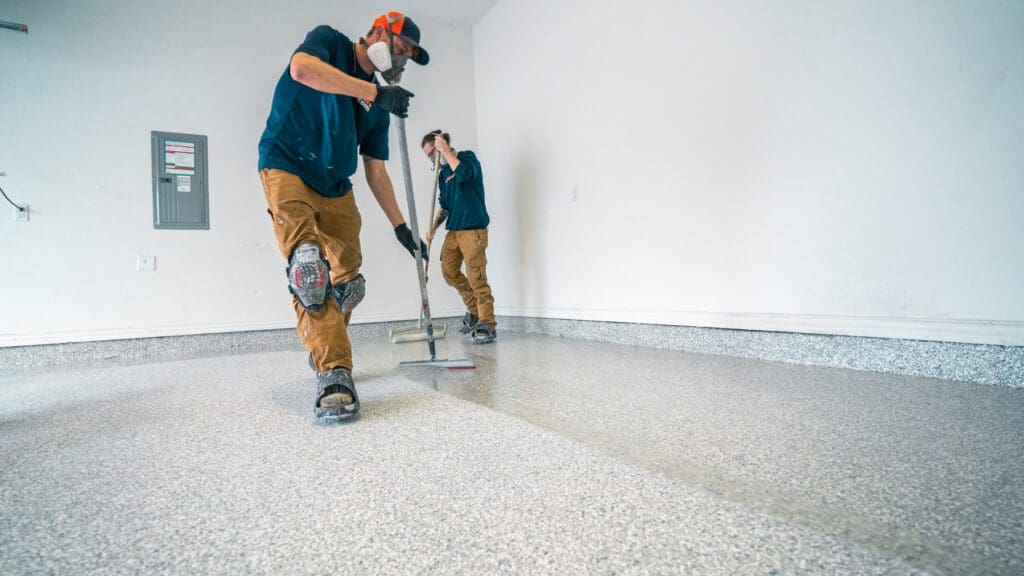
Imagine a garage floor as gleaming and smooth as your vehicle fresh off the lot. That’s where epoxy makes the difference. It’s not just an ordinary coating. It’s a thermosetting resin that transforms through curing into a solid, resilient layer that offers much more substance and toughness than standard epoxy garage floor paint. Epoxy doesn’t simply sit atop the concrete—it chemically reacts to form a sturdy, enduring surface adept at handling all sorts of spills and marks, plus the rigors of daily usage.
The hard-wearing nature of epoxy garage floors stems from their composition—a blend of resins and hardening agents—which, upon mixing, trigger a chemical reaction resulting in a stiff plastic material that adheres firmly to its base layer. This robust bond wards off deterioration over time and ensures lasting strength underfoot. The question then presents itself: why opt for anything other than this ruggedly durable flooring choice?
Benefits of Epoxy Floors
Garage floor epoxies, commonly referred to as epoxy floors, provide a multitude of advantages that render them an excellent option for garage flooring. These floors are adept at resisting moisture, chemicals, dirt, and debris from vehicles and road salts while providing long-term value with their low lifecycle costs — underscoring their cost-effective nature.
In addition to their durability against various elements, the surface of these epoxy floors facilitates effortless cleaning and upkeep, making them particularly suitable for garages that experience high levels of activity. The robustness, coupled with ease of maintenance, is precisely why epoxy flooring solutions are gaining widespread acceptance in garages nationwide.
Suitable Applications

But remember, the application of epoxy floors extends beyond just garages. Its adaptability makes it suitable for a broad range of industrial environments including warehouses, factories, and other heavy equipment areas that can take advantage of both its robustness and visual attractiveness.
To this versatility, epoxy flooring acts as an excellent remedy for typical garage floor problems like scratches, oil stains, and fissures. It helps preserve a resilient and pristine surface. Thus, whether you are looking to enhance your home’s garage or if you’re a commercial proprietor in search of a solid flooring solution – consider epoxy as the go-to option.
Factors Affecting Garage Floor Epoxy Costs

You may be curious about the potential financial commitment required for an epoxy garage floor. The price of installing this type of flooring can differ, largely influenced by material and labor expenses.
For the installation labor of epoxy garage floors, you could expect to pay anywhere between $3 and $5 per square foot, depending on your contractor selection and where you live. Meanwhile, materials for an epoxy floor might set you back somewhere between $2.50 and $3.50 per square foot, which plays a role in calculating the total cost of your flooring project.
Garage Size and Surface Area
The cost of applying epoxy on garage floors is greatly influenced by the size of your garage. An application of epoxy to a one-car garage that measures 250 square feet will typically range from $1,500 to $2,000 in price. For larger garages that are between 400 and 500 square feet in area, you can expect costs ranging from $2,400 to as much as $3,500.
It’s noteworthy that the national average expense for installing an epoxy flooring system within a garage hovers around approximately $2,227. This figure might fluctuate based on geographical location and exact dimensions of your space. While it’s true that investing in an epoxy floor initially may appear somewhat costly, it’s important to factor in the long-lasting resilience and minimal upkeep requirements which often render this kind of flooring solution quite economically advantageous over time.
Choosing the Right Epoxy Coating for Your Garage
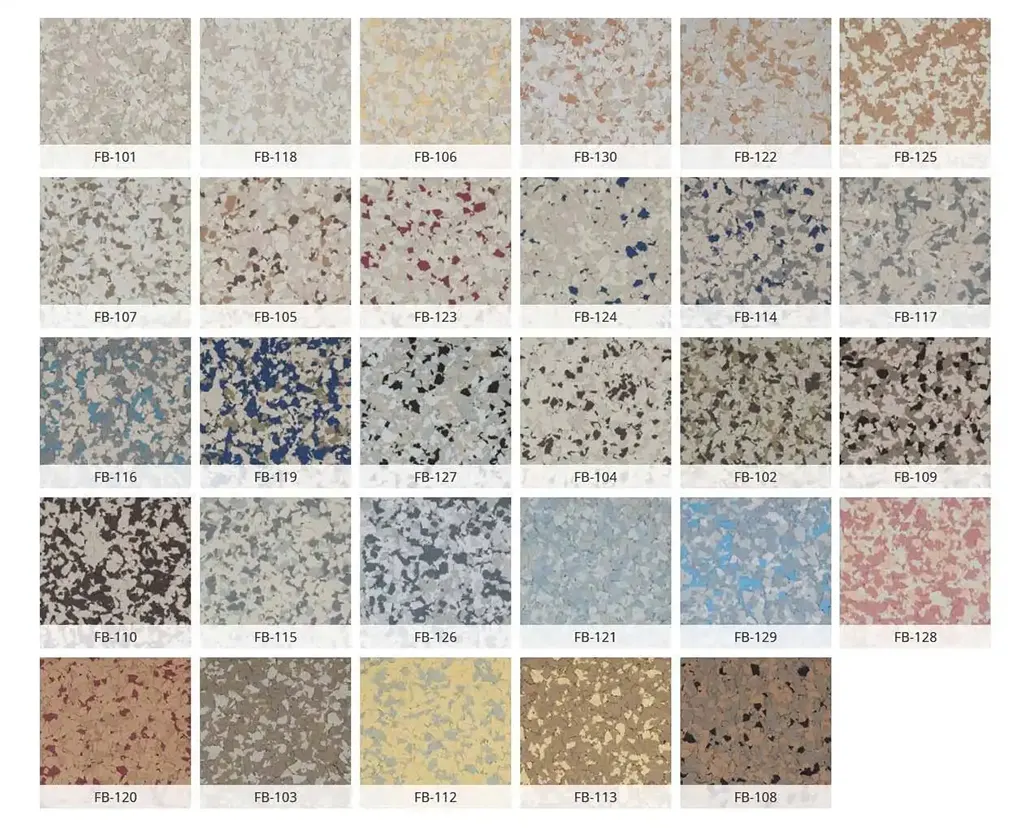
Selecting an appropriate epoxy coating for your garage floor requires careful consideration, as not every type of epoxy is suitable for all garages. Various kinds of epoxy coatings offer distinct benefits and drawbacks that impact factors such as their longevity, resistance to chemicals, and the complexity of applying them.
Epoxy resins designed specifically for use on garage floors typically feature characteristics like:
Resistance to extreme temperatures
Effective electrical insulation properties
The ability to withstand UV exposure
Elevated glass transition temperatures
Such attributes enhance the durability of these coatings when applied to a garage floor.
Water-Based Epoxy
Water-based epoxy is recognized as a user-friendly option for those who wish to apply an epoxy floor coating themselves. The product’s viscosity is similar to that of regular paint, which eases its application and makes it perfect for DIY undertakings.
The flow properties inherent in water-based epoxy contribute to an uncomplicated application experience, thus positioning this type of coating as a prime selection for homeowners looking to undertake their own garage floor finishing projects with ease.
Solvent-Based Epoxy
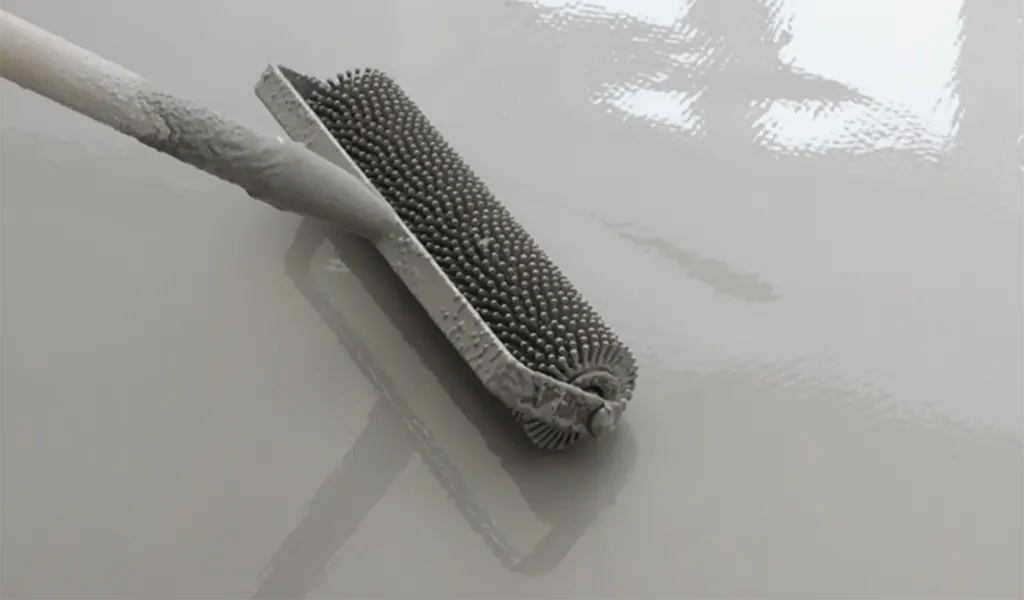
Conversely, solvent-based epoxies have a higher concentration of volatile organic compounds (VOCs) compared to their water-based counterparts. This composition provides an equilibrium between resilience and application simplicity. Such industrial-grade epoxies are tailored for settings that demand robust and enduring floor coatings.
These solvent-based varieties boast elevated levels of solids, which accounts for their increased thickness and superior durability relative to alternative solvent-based coatings.
Solid Epoxy
If you’re seeking the utmost in resilience, solid epoxy coatings should be your go-to choice. With their high solids content, these coatings offer unmatched durability that can withstand heavy impacts, chemicals, stains, and moisture—making them perfect for areas subjected to harsh conditions.

Solid epoxy stands out as particularly suitable for commercial and industrial settings or garages demanding robust epoxy systems because of its exceptional chemical resistance and hard-wearing properties.
Preparing Your Garage Floor for Epoxy Application
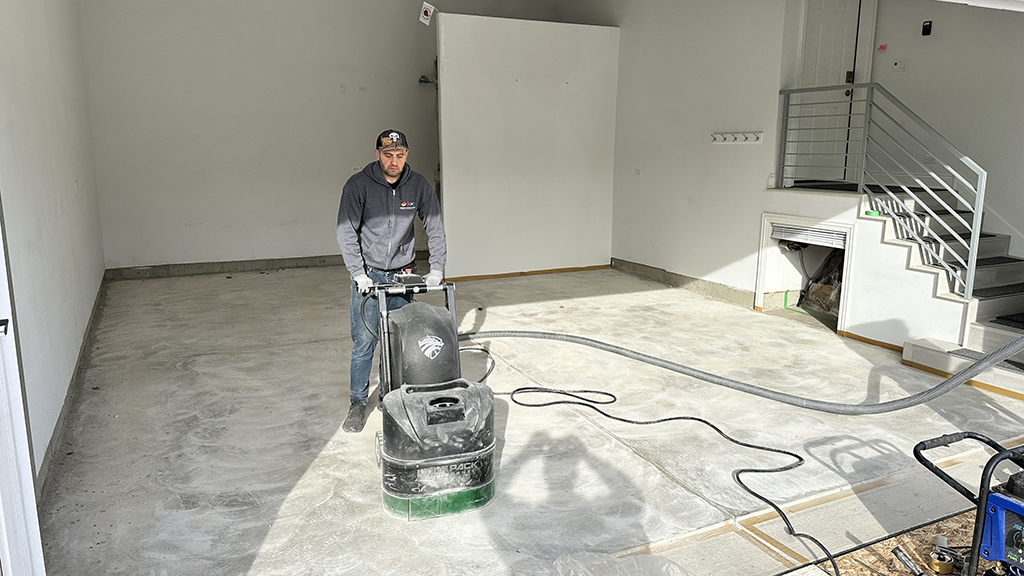
Once you have chosen an epoxy coating that meets your requirements, the following phase involves priming your garage floor for its application. The preparation process is vital as it significantly affects how well the coating sticks to the floor and thus determines the overall performance of the epoxy flooring.
Begin by thoroughly clearing out your garage. Ensure that all items are removed from both the floor space and any shelving units along the edges of the area.
Cleaning and Removing Stains

Firstly, the preparation stage is crucial and demands meticulous cleaning of the garage floor. To achieve strong adherence of the garage floor coating, it’s essential to remove all traces of chemicals, oil spills, dirt particles, and assorted debris from the surface. The process includes scrapping off any hardened substances followed by a thorough vacuuming to clear away loose materials. Ensuring that the floor is impeccably clean will significantly enhance the outcome when applying coatings.
Following this initial cleanse, one should proceed with washing down every inch of your garage flooring using hot water. Then thoroughly rinse it off to eliminate any lingering residues. Afterward, allow for adequate drying time before moving forward. For areas blighted by persistent grease marks or tough stains on your concrete slab or tiles, deploying degreasers or other effective cleaners specifically designed for such challenges can yield a pristine surface ready for its new protective coat.
Repairing Cracks and Damages
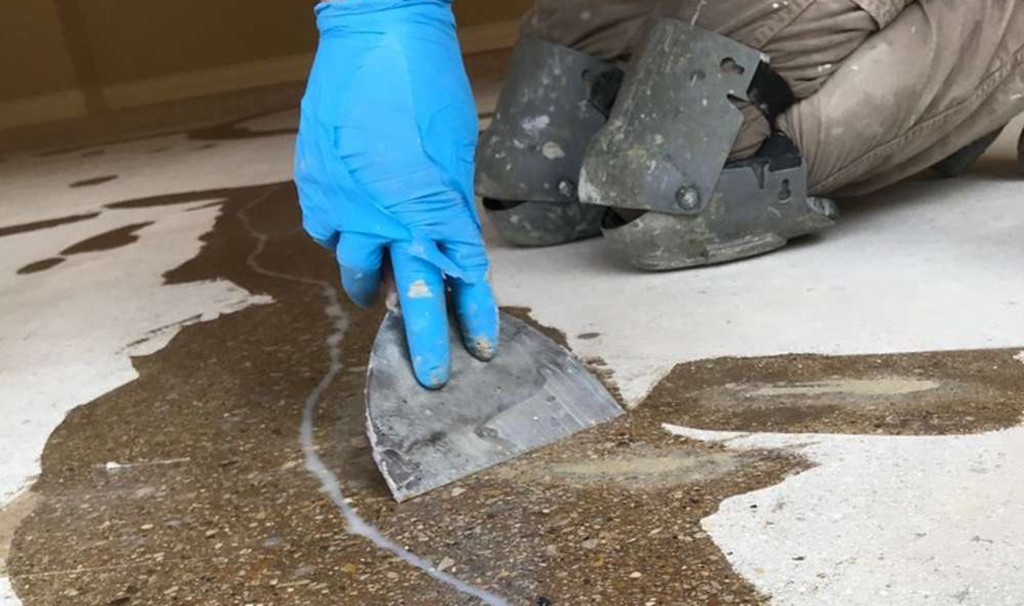
Once the surface of the floor has been thoroughly cleaned, attention must be turned to mending any fractures or imperfections within the concrete. This is vital for achieving a uniform and unblemished coating. The following materials may be utilized for these repairs:
Patcher paste
Liquid cement crack fillers
Polyurethane crack repair products
Patching compounds
It’s advisable to use a self-leveling filler on floor joints to refine the surface’s smoothness before applying epoxy.
Acid Etching or Grinding
In the final stage of the preparation process, the concrete’s surface needs to be textured to improve epoxy’s adhesion capabilities. This texturization can be achieved by acid etching, which involves spreading an acidic substance across the concrete’s top layer to open up pores and generate a rougher profile conducive to secure bonding with epoxy.
Another method is grinding, wherein removing part of the outermost layer from the concrete results in a coarser texture that promotes superior adherence for the subsequent application of an epoxy coating.
Step-by-Step Guide to Applying Epoxy on Your Garage Floor

After thorough preparation, it is time to move forward with the application of the epoxy coating using your chosen epoxy kit. This stage requires a range of equipment such as rollers, squeegees, trowels, sprayers, power washers and shop vacuums along with both power and manual tools. Ensure that you are equipped with protective gear including spiked shoes for traction on wet surfaces, masks for respiratory protection against fumes or particles in the air and gloves to protect your hands during this process.
Mixing the Epoxy Components
Initially, it is essential to accurately blend the components of the epoxy. This requires mixing two parts of epoxy resin with one part hardener by volume and maintaining consistent stirring for a minimum duration of three minutes to guarantee thorough integration.
Once combined, it’s important to allow the mixture to rest for about 30 minutes. During this period, the critical chemical reaction within the epoxy will take place prior to its application.
Application Techniques
Proceeding with the actual application, follow these steps:
Initially, safeguard walls and areas that are not part of the floor using tape and plastic sheeting to prevent contamination from dust and debris.
Tackle applying epoxy in smaller sections—consider a 10 by 10-foot space at a time—beginning at the peripheries before proceeding to coat the main expanse of the floor with a roller.
In cases where color chips are being incorporated, sprinkle them onto the freshly applied epoxy without delay.
Curing Time and Temperature Considerations

Following the application of epoxy, it must undergo a curing period as per these steps.
The initial layer or base coat of epoxy on the garage floor should be allowed approximately 12 to 24 hours of drying time before adding another layer.
Subsequent to laying down both the epoxy and color chips, a protective topcoat is applied over them.
This topcoat then needs between 24 to 72 hours to dry adequately.
Once this final protective coating has been put in place, you must wait at least 24 hours before walking on the garage floor. For a complete cure that can support vehicle traffic without damage, refrain from driving on it for a duration spanning from four up to seven days post-application.
DIY vs. Professional Installation: Pros and Cons
If you’re deliberating on the application of garage floor epoxy, you can opt for either a DIY method or engage the services of a professional. Both routes come with their respective pros and cons, and selecting the best fit depends largely on your individual circumstances.
For those who enjoy DIY home improvement tasks, applying epoxy to your garage floor can be quite fulfilling. Products such as ArmorClad are designed to facilitate easy DIY applications, allowing individuals without professional expertise to effectively coat their garage floors with epoxy.
DIY Epoxy Application
Opting for DIY installation requires a commitment to carefully prepare the floor, apply the epoxy, and wait for it to fully cure. This task demands thorough preparation of the surface, which includes degreasing the concrete, etching or sanding down the area, applying epoxy section-by-section, and adhering to proper curing timeframes.
Though at first glance, handling your own epoxy flooring may seem more economical than hiring professionals, incidental expenses can add up. Ultimately, these costs could equal or even surpass what you would pay for professional installation services.
Hiring a Professional Installer
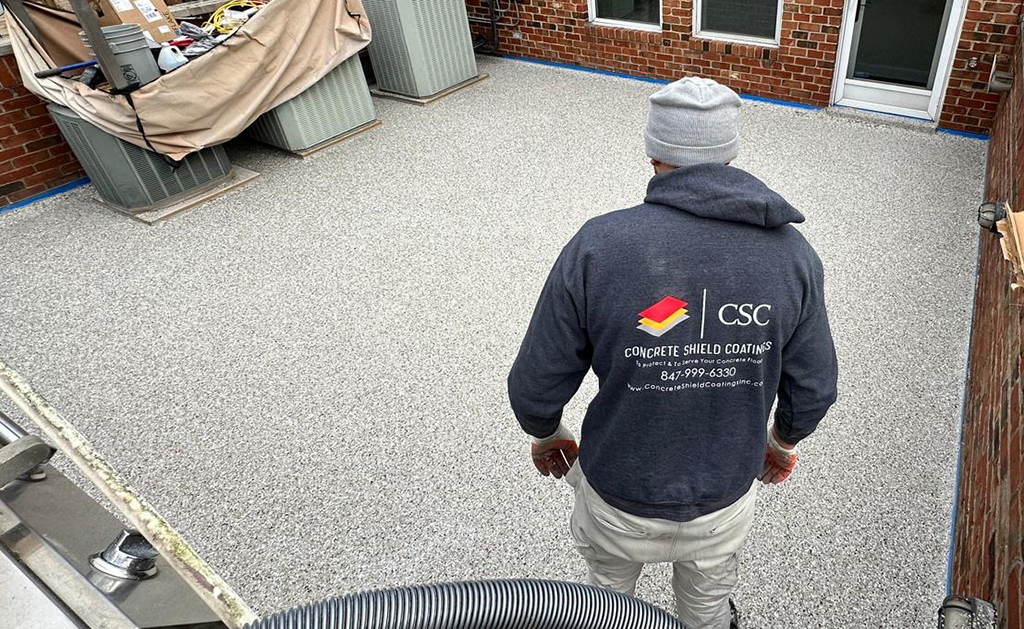
Alternatively, enlisting the services of a professional installer guarantees an expertly applied and superior-quality finish due to their advanced skill set and comprehensive understanding of the coating material. Professionals come equipped with specialized tools and equipment designed to achieve outcomes that are more resilient and have a more refined appearance than most do-it-yourself efforts. Opting for professional assistance can prevent typical issues such as:
inadequate mixing or application processes, which may severely impact both the floor’s longevity and its visual appeal
inconsistent spreading of material, leading to an uneven final look
formation of bubbles or air pockets within the applied coating
incorrect drying or curing methods resulting in diminished strength and reduced durability
Employing a skilled installer circumvents these potential pitfalls while delivering a seamless, enduring coat on your flooring surface.
Customizing Your Epoxy Garage Floor
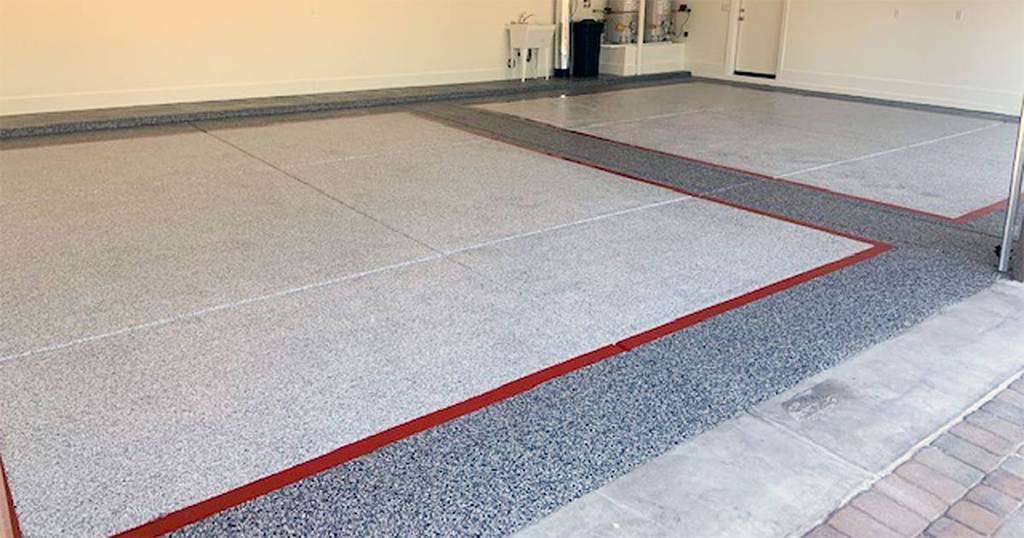
Epoxy garage floors offer exceptional versatility, allowing you to tailor your floor’s appearance and functional qualities to suit your personal taste or the specific needs of your garage. With an expansive selection of more than 140 color choices for epoxy flooring, there is virtually no limit to the customization possibilities for your garage space.
Color Combinations
Regarding hues for your garage floor, the palette includes:
Classic shades such as beige, black, and charcoal that provide a conventional aesthetic
Choices of flakes and metallics to embellish your garage flooring with an ornamental flair
Metallic epoxy optionsthat are capable of replicating the luxurious look akin to marble.
Color Flakes and Chips
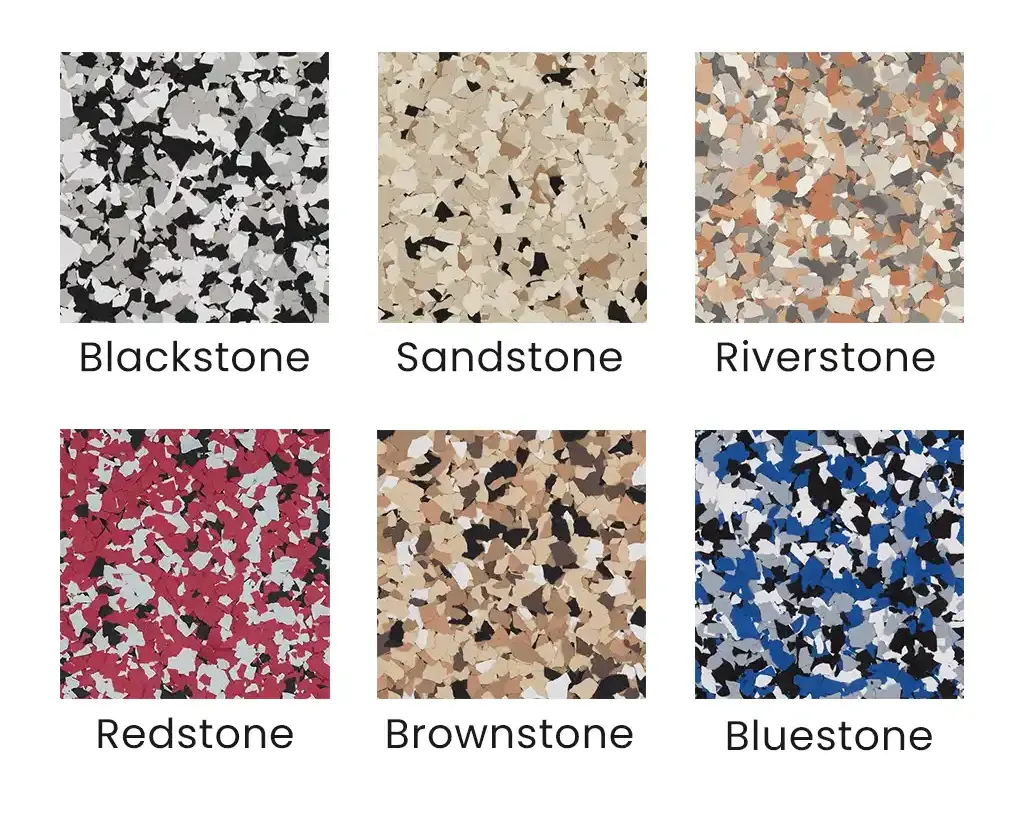
Flake and chip additions provide both texture and diverse coloration for epoxy garage floors. A variety of sizes and blend options, such as the Desert Sand or Harley Mix, allow for a tailored appearance on your epoxy floor.
These enhancements elevate the garage floor’s visual appeal and enhance traction on the epoxy flooring’s surface.
Unique Patterns and Designs
To achieve a personalized aesthetic, you have the liberty to embed distinctive motifs and styles into your garage floor’s epoxy coating. Specialty finishes, such as metallic or brindle flake choices, allow for innovative looks that can mimic the elegance of granite stone or provide a glimmering metal effect.
Epoxy flooring extends its flexibility to accommodate various creative desires. From organizing pennies in a checkerboard formation and blending multiple hues for an elegant marbled look to embedding custom logos or bespoke artistic creations—your garage’s epoxy floor can be tailored to reflect your unique tastes.
Maintenance and Care for Your Epoxy Garage Floor
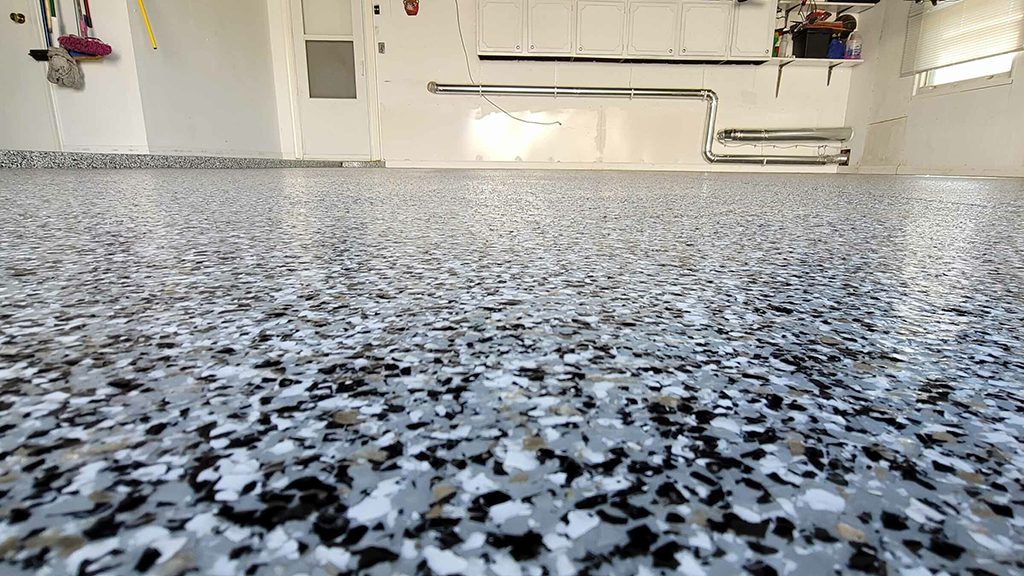
To ensure longevity and maintain the visual appeal of your epoxy-coated garage floor, proper upkeep is essential. The amount of maintenance needed for an epoxy garage floor varies based on how much dirt it encounters and the conditions unique to your workspace. Regular care will keep that stunningly installed epoxy surface in top condition for years to come.
Cleaning Techniques
In the maintenance of epoxy coatings, it is essential to opt for cleaning agents that are non-enzymatic and have a neutral pH value. Appropriate choices for this purpose comprise:
Ecolab High-Performance Neutral Cleaner
Ivory or Dawn dishwashing liquid
Simple Green
JetRock Cleaning Solution JRCS1000
It is important to steer clear of cleansers containing bleach, vinegar, citrus components, ammonia or enzymes because these substances could harm or alter the coloration of the epoxy coating.
To maintain cleanliness and prevent buildup on your coated surfaces, regular sweeping or using a dust mop to remove debris and dirt is advisable.
Preventing Scratches and Wear
To safeguard against scratches and deterioration, consider these measures:
Deploy mats or rugs in areas of substantial foot traffic to diminish the epoxy surface’s exposure to direct wear.
Promote the utilization of protective pads beneath bulky furniture pieces.
Conduct frequent checks and substitute any tattered casters or wheels that might inflict abrasions on the epoxy flooring.
Adhering to these guidelines will help maintain the appearance of your epoxy floor and protect it from harm.
Stay vigilant about sharp implements and limit their interaction with the floor as a precautionary step against accidental scratching.
Recoating and Repair
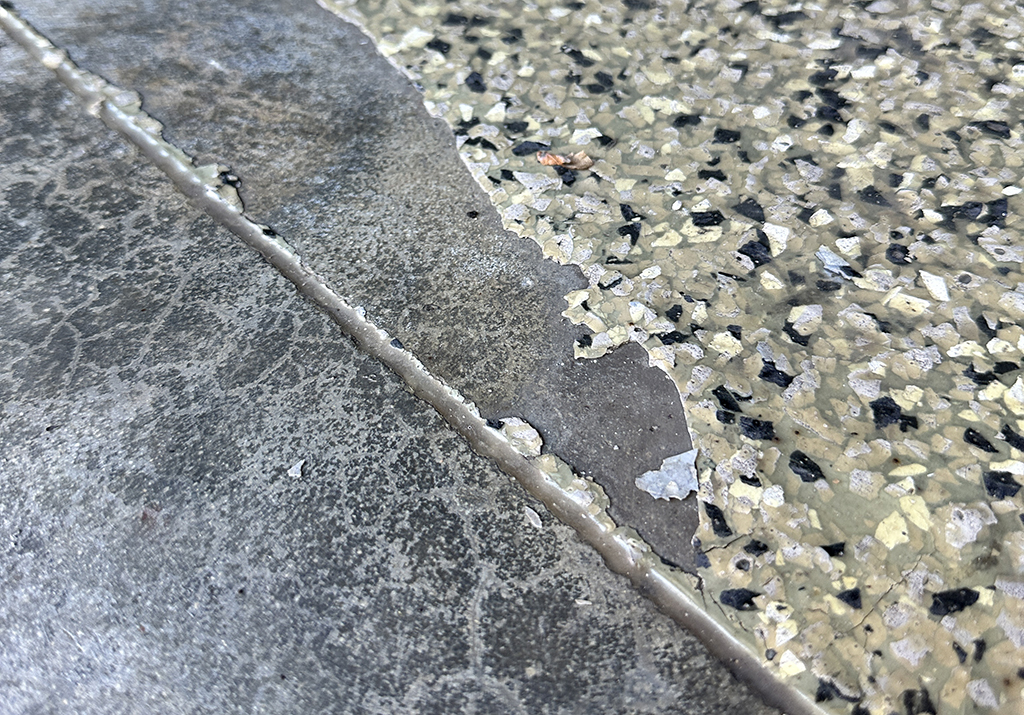
As time passes, your epoxy floors might require recoating or repair. Here’s what you can do to maintain and fix them:
Adding a top coat is beneficial for increasing the longevity of your floor. It offers extra protection from abrasions, marks, sunlight exposure, and harsh chemicals.
Small chips and fissures are repairable using either an epoxy filler kit or mortar.
In cases where the damage is widespread, resurfacing might be necessary before a fresh layer of epoxy can be applied.
When dealing with discoloration issues in epoxy flooring systems, one can employ colored sealants or water-based dyes as remediation methods. To rectify scratches and deep cuts on the surface of your floor coating system, sand down the compromised area gently but thoroughly. Ensure it’s clean before promptly applying another coat of the original base material used for your floor to avoid any additional chipping away at its integrity.
Common Issues and Troubleshooting
Epoxy floors are renowned for their durability and longevity, yet they are not without potential complications. Challenges with epoxy flooring often stem from improper application techniques, adverse weather conditions exposure or insufficient professional know-how during the installation process.
Hot Tire Pickup
Hot tire pickup is a frequent problem. The warmth of car tires can soften an epoxy coating, making it adhere to the tires. When the tires cool and contract, they lift off pieces of epoxy from the floor, leading to peeling.
To avoid this issue, it is recommended that top-quality epoxy products that are more resistant to heat be utilized. Superior-grade epoxies will offer better protection against hot tire pickup due to their enhanced ability to withstand higher temperatures.
Moisture and Waterproofing
The presence of high humidity or moisture can interfere with the curing process of epoxy resin, increasing the likelihood of it peeling off. If moisture becomes entrapped beneath the epoxy coating, complications such as bubbling may occur, or there is a chance that the epoxy could detach from its concrete base.
Hydrostatic pressure stemming from moisture within concrete has the potential to force an epoxy coat to rise and separate from its underlying layer.
Peeling or Chipping
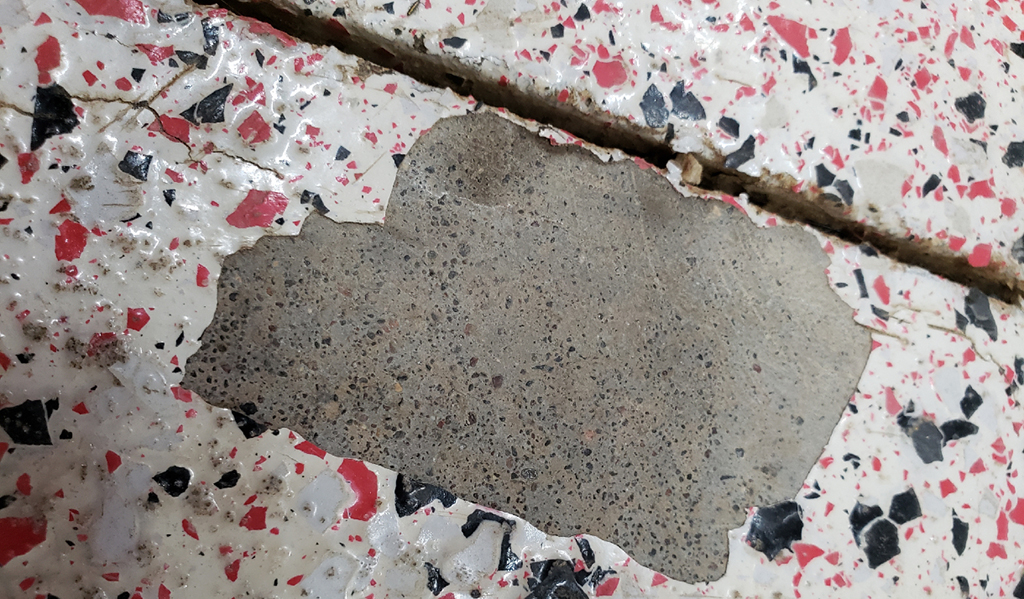
Various factors, like inadequate surface preparation, improper environmental conditions at the time of application, or oils and debris on the surface, can lead to peeling or chipping of epoxy floors.
In order to avert issues such as discoloration and peeling with epoxy floors:
Make certain that correct installation procedures are employed
Take into account the environmental conditions during both the application and curing stages
If in doubt about how to proceed, consult with a professional for guidance.
Summary
To summarize, opting for an epoxy garage floor offers a robust, visually appealing, and economical choice for your garage space. We have thoroughly explored everything from the basics of what constitutes epoxy to selecting the appropriate variant, as well as application techniques and upkeep of your freshly installed flooring. With proper preparation and maintenance, you can ensure that this hard-wearing surface will endure for numerous years while offering a secure and attractive environment within your garage for both vehicles and various other uses.
Frequently Asked Questions
Can I apply epoxy on my garage floor myself?
Certainly, with proper preparation and the necessary tools, you can self-apply epoxy to your garage floor. However, for optimal outcomes, it’s essential that you adhere strictly to the provided guidelines.
How long does epoxy flooring last?
Epoxy flooring’s durability, which can extend for numerous years when adequately maintained, is influenced by the traffic it endures and the grade of the epoxy used. Ensuring regular maintenance and utilizing premium materials are key to optimizing its lifespan.
Can epoxy flooring be repaired if it gets damaged?
Certainly, small imperfections, such as chips and cracks in epoxy flooring, can be fixed using either mortar or a kit designed for patching epoxy.
If the floor damage is more severe, resurfacing the entire area before applying a fresh layer of epoxy might be necessary.
Is epoxy flooring waterproof?
Epoxy flooring is highly resistant to water. Ensuring it remains properly sealed is crucial for preventing damage from moisture.
Can I customize the color of my epoxy garage floor?
Certainly, the customization of your garage floor’s color is possible with epoxy, as you can select from an array of hues and enhance the texture by incorporating color flakes or chips into your epoxy garage floor.

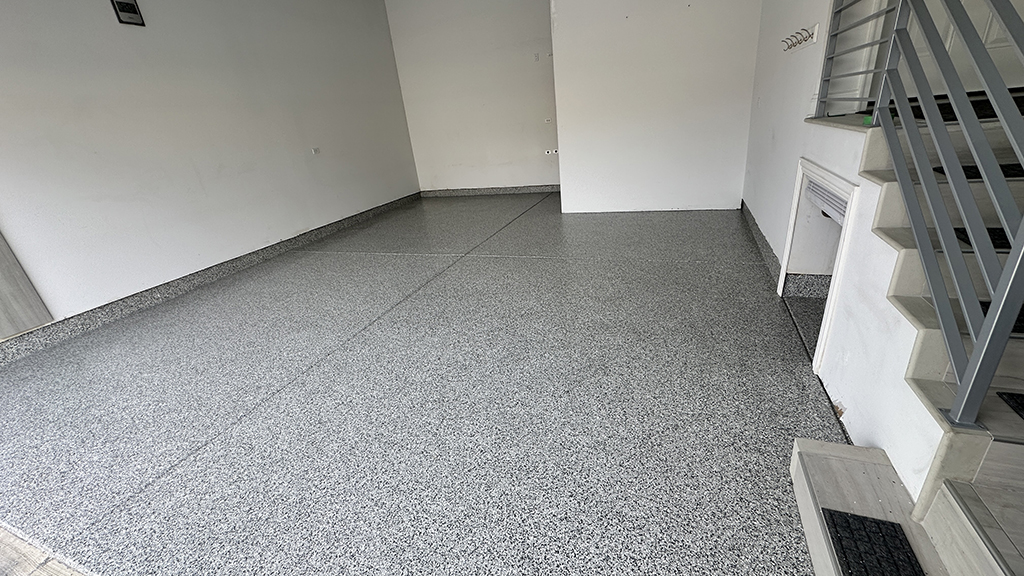
Comments
One response to “Top-Quality Epoxy for Garage Floor: Your Ultimate Guide to a Durable Finish”
[…] Garage floors are unique in that they face a variety of challenges. You are probably aware of these challenges if you have done any work on your garage at all. Ranging from exposure to chemicals and oil spills to the weight of heavy machinery and vehicles – there are lots of things that can go wrong and make garages an especially tough space to work on and work in. These factors make concrete sealing and garage floor coatings not just an option but a real necessity. […]